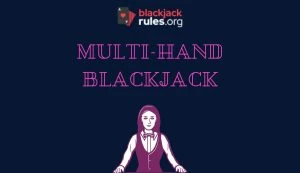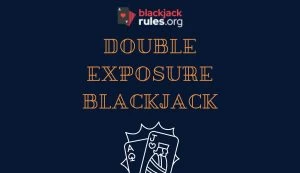Below are the most common terms that are used in the game of Blackjack:
21: The name of the game and the target score to beat without going over. This simply means what it is, twenty-one, and when playing blackjack this is the highest valued hand you can have; get more than 21 and you have bust.
- Ace: The most useful card in the deck, which can be counted as either 1 or 11.
- Action: The total amount of money bet over a certain period.
- Ace Poor or Ace Rich: A counting term referring to the number of aces dealt in a game.
- Anchor/Anchorman: The last player to act before the dealer, also known as ‘third base’.
- Bet Spread: The difference between a player’s highest and lowest bet values.
- Blackjack: The name of the game and a hand that contains an Ace and a card valued at 10. This is the best hand you can have and it cannot be beaten but can be matched.
- Box: The outlined area on the table where players place their cards and chips.
- Burn Card: The top card of the deck, discarded after shuffling or switching dealers to prevent players from knowing the first card.
- Bust: A hand that goes over the total point value of 21, resulting in an automatic loss. This is when your hand exceeds a total of 21, which means you have automatically lost that hand of Blackjack.
- Card Counting: A strategy that determines the ratio of high cards to low cards in the deck and adjusts bets accordingly.
- Chip Down: Decreasing the bet amount from the previous round.
- Chip Up: Increasing the bet amount from the previous round.
- Cold Deck: A deck of cards that has dealt several bad hands in a row, opposite of a ‘Hot Deck’.
- Colour Up: Exchanging low denomination chips for higher-value ones before leaving a table.
- Cut/Cut Card: Splitting the deck with a plastic card after shuffling. A plastic card used to cut the decks.
- D9: A rule where you can only double hands that value 9, 10, or 11.
- DA2: A rule where you can double any two cards.
- DAS/NDAS: ‘Double After Split’, where you can double down after splitting a hand, or ‘No Double After Split’, where you cannot.
- Denomination: This is simply the face value of the cards. An Ace being One or Eleven, A King, Queen Jack are worth Ten and all remaining cards are worth their respective values.
- Double Down: Doubling the bet and receiving only one more card from the dealer. This is when you double your initial wager on a hand of Blackjack and by doing so you will be dealt a further card. You should only make this maneuver when the Blackjack strategy dictates.
- Double Exposure: A blackjack variant where both dealer cards are dealt face up.
- Draw: Receiving another card from the dealer, also known as ‘hit’.
- Early Surrender: Surrendering the hand before the dealer checks their hole card, resulting in a 50% loss of the bet.
- Face Cards: Picture cards or Jack, Queen, and King, each worth 10 points.
- First Base: The first player to receive cards, located on the dealer’s far left.
- First Baseman: The player seated to the left of the dealer and first to act.
- Hard Hand: A hand without an Ace or a hand where the Ace must count as 1 to avoid busting.
- Hit: Asking for another card, which can result in busting if the total goes over 21. This is a free option and costs you nothing.
- Hole Card: The dealer’s face-down card, not revealed until after players have acted on their hands. When a Dealer deals his own hand, one of the cards is face up and the other is face down; the latter card, i.e., the face down one, is called the Hole Card.
- Insurance: A side bet that the dealer has blackjack, paid at 2:1 if the dealer does have blackjack. This is an optional side bet you make when the Dealer is showing an Ace on their face-up card; this bet will be successful only if the Dealer has a Blackjack. An Insurance bet will cost you exactly half of your initial stake.
- Late Surrender: Surrendering the hand after the dealer checks their hole card, resulting in a 50% loss of the bet.
- Natural: Another name for a ‘blackjack’ hand, a two-card total of 21.
- Penetration: The number of cards dealt before shuffling in a shoe game.
- Pitch Game: A blackjack game dealt from the hand of the dealer, typically using 1 or 2 decks.
- Push: A tie where the player and dealer have hands with the same total below 22. This is a tie bet and means that both you and the Dealer have the same hand; in such circumstances, no one wins, and your stakes are returned.
- Running Count: A simplified count of high and low cards in the deck, used in basic strategy.
- Shoe: A device used to hold multiple decks of cards, typically 4, 6, or 8.
- Shoe Game: A blackjack game dealt from a shoe, typically using more than 2 decks.
- Soft: A soft hand is a hand that includes an Ace valued as 11.
- Soft Double: Doubling down on a soft hand.
- Soft Hand: A hand that includes an Ace that can be counted as either 1 or 11 without going bust.
- Split: If you are dealt two alike cards, you can separate them into two new hands, but you will have to place another bet of the same value as your initial bet.
- Stand: Ending the hand without taking any additional cards. This basically means you wish to stick on the hand you have and get dealt no further cards.
- Stiff Hand: A hard hand that totals between 12 and 16, more likely to bust when another card is drawn.
- Surrender: You will lose half your stake, but when you surrender, you will be removed from that hand of Blackjack. There is a Late Surrender option and in some cases, an Early Surrender option.
- True Count: The actual count of high and low cards in the deck, used in card counting strategies.
- Up Card: The dealer’s card played face up.
These terms are essential for understanding the rules and strategies of blackjack, and mastering them can significantly improve your chances of winning.



